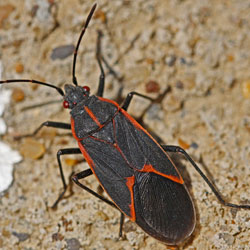Adult boxelder bugs are about 1/2-inch long, black with orange or red markings, including three stripes on the prothorax, the area right behind the head. Their wings lay flat over their bodies, overlapping each other to form an ‘X’. The immature nymphs are 1/16th-inch long and bright red when they first hatch. As they grow older and become larger, they are red and black. You can potentially see all stages at any given time during the summer.
Boxelder bugs emerge from overwintering sites during spring as the weather starts to warm up. Adults feed on low vegetation and seeds on the ground during spring and early summer, and begin mating a couple weeks after they started feeding. Starting in mid July, they move to female seed-bearing boxelder trees where they lay eggs on trunks, branches, and leaves. They are rarely found on male boxelder trees. Boxelder bugs may also feed on maple or ash trees. There is no noticeable feeding injury to these trees. During years of high populations, you may find nymphs on the ground or in gardens feeding throughout the summer.
During late summer and fall, boxelder bugs start to leave the trees from where they were feeding to find protected areas for the winter. Although nymphs may be present in the fall, only fully grown adults survive the winter. Adult boxelder bugs typically can fly several blocks, although in some cases they can travel as far as two miles.
Some homes are especially attractive to boxelder bugs, while neighboring buildings may have few. This usually depends upon the amount of sunny exposure a building receives. Boxelder bugs like warm areas and are attracted to buildings with a large southern or western exposure. Buildings standing taller than surrounding structures or standing isolated on flat ground can also attract large numbers of boxelder bugs. Color does not appear to influence boxelder bugs as they are found on buildings of all colors.
Prevention Tips
Repair or replace damaged window and door screens.
Seal areas where cable TV wires, phone lines, and other utility wires and pipes, outdoor facets, dryer vents and similar objects enter buildings.
Install door sweeps or thresholds to all exterior entry doors. Install a rubber seal along the bottom of garage doors.
Seal with caulk or for larger spaces use polyurethane expandable spray foam, copper mesh, or other appropriate sealant.

